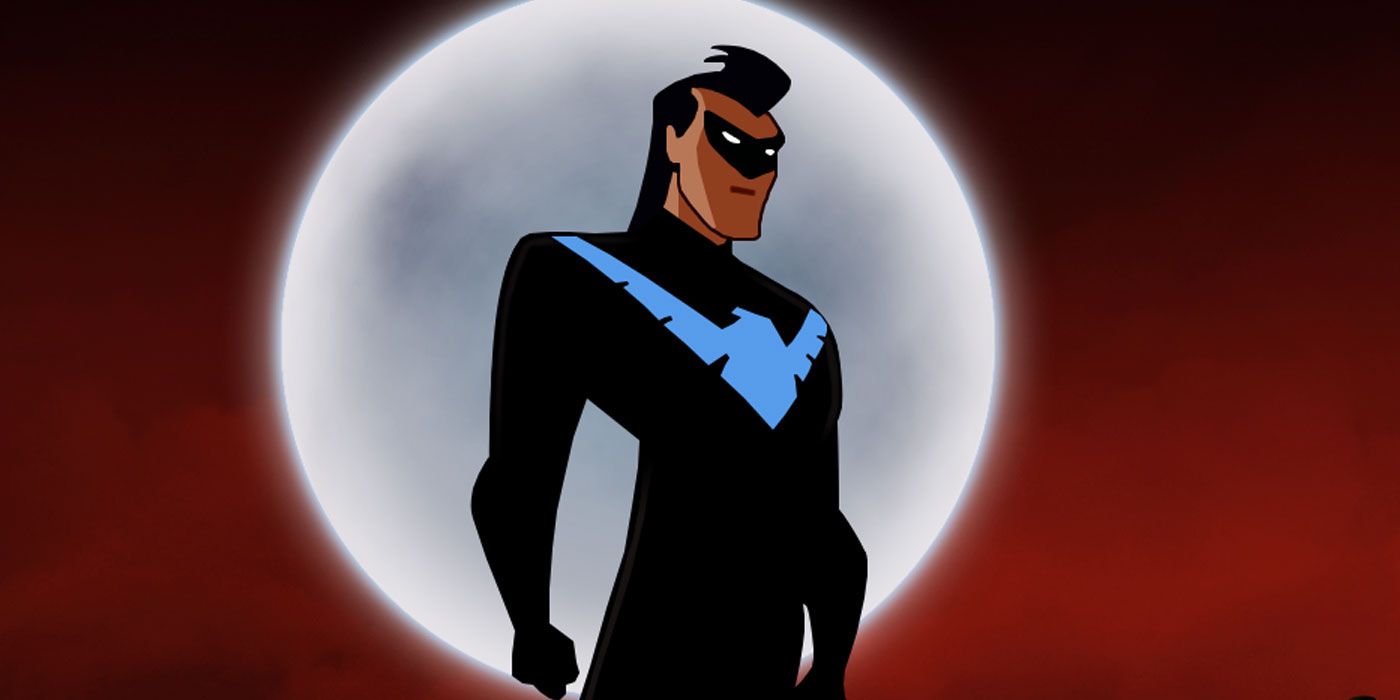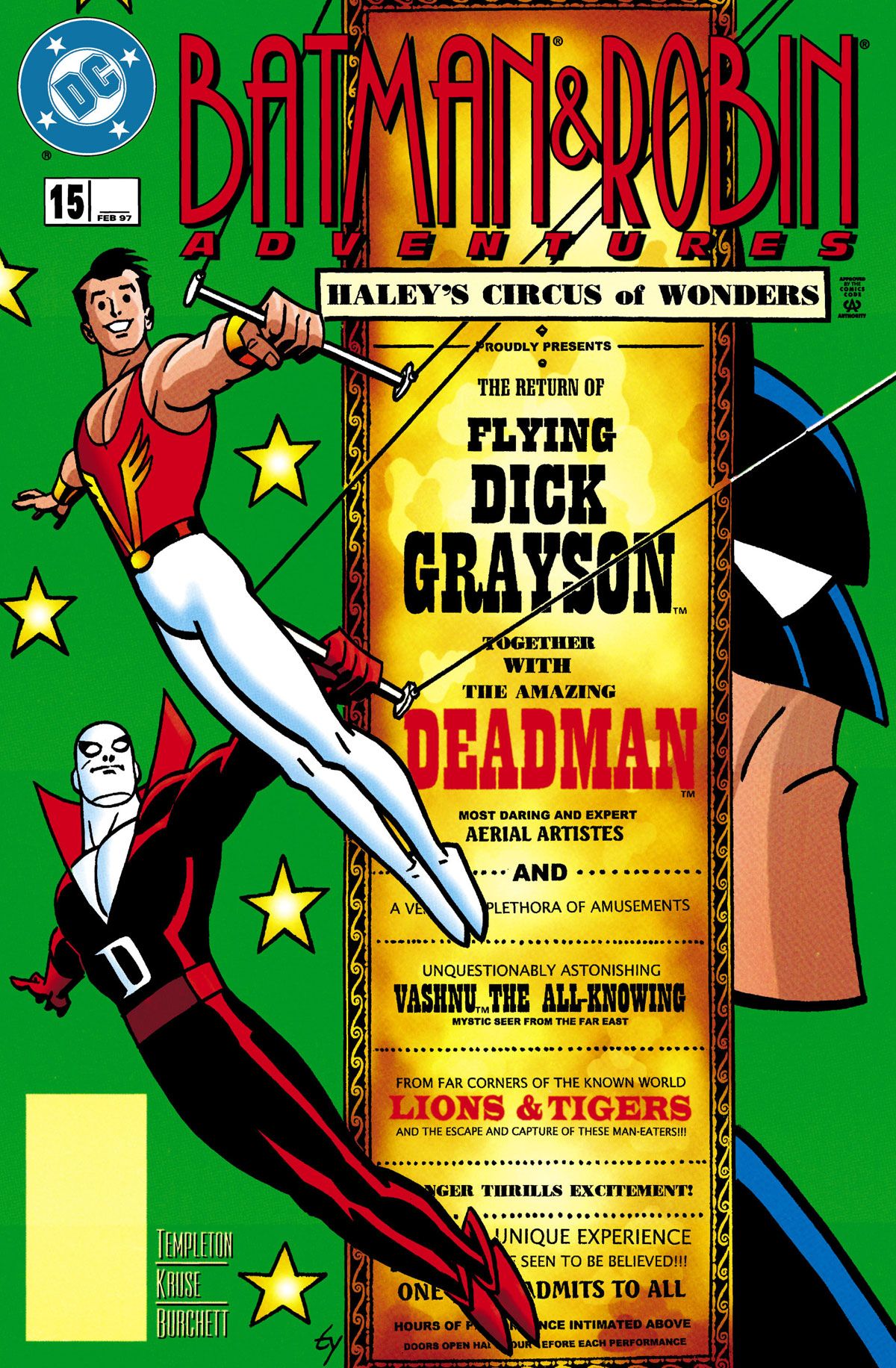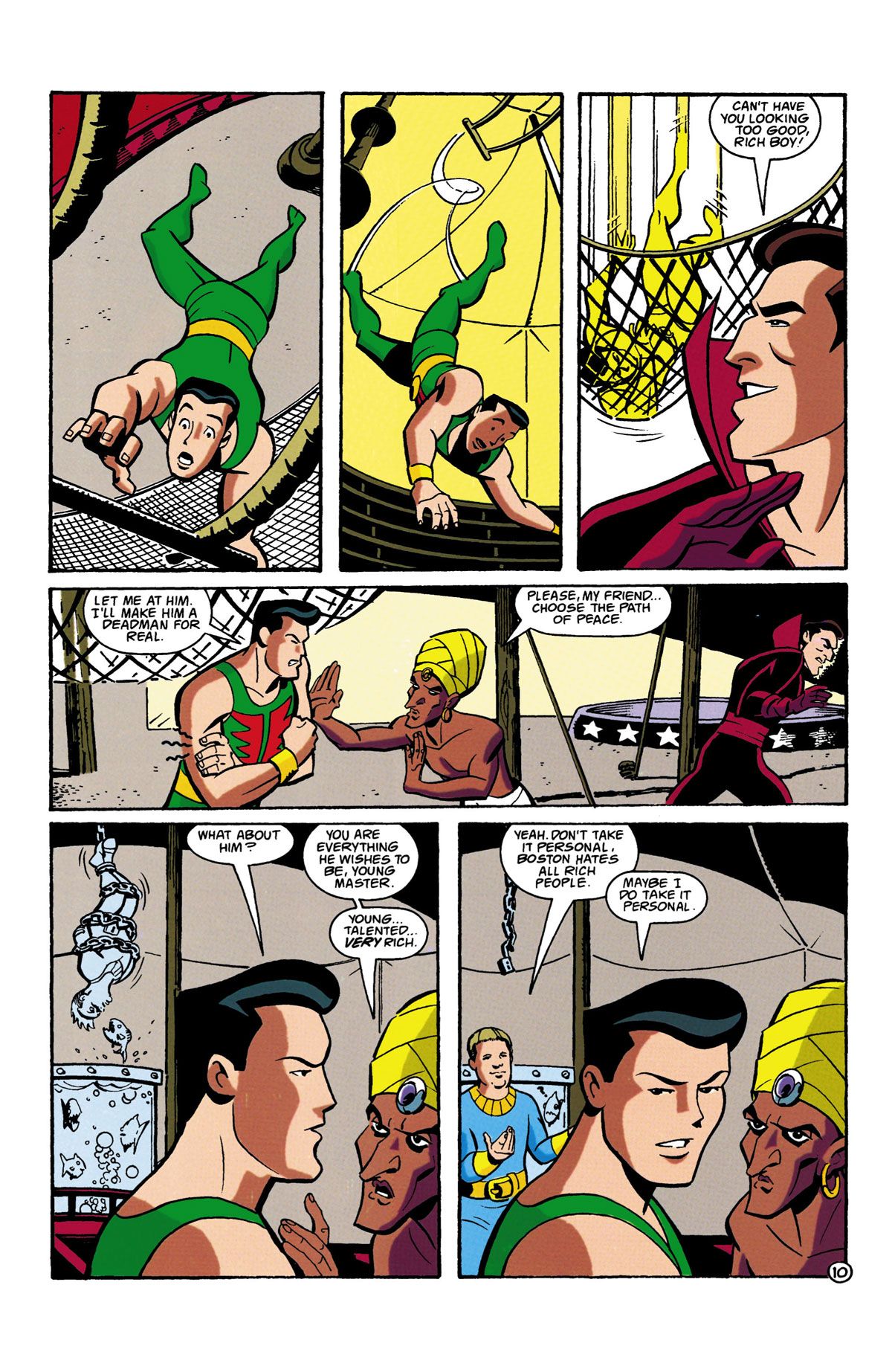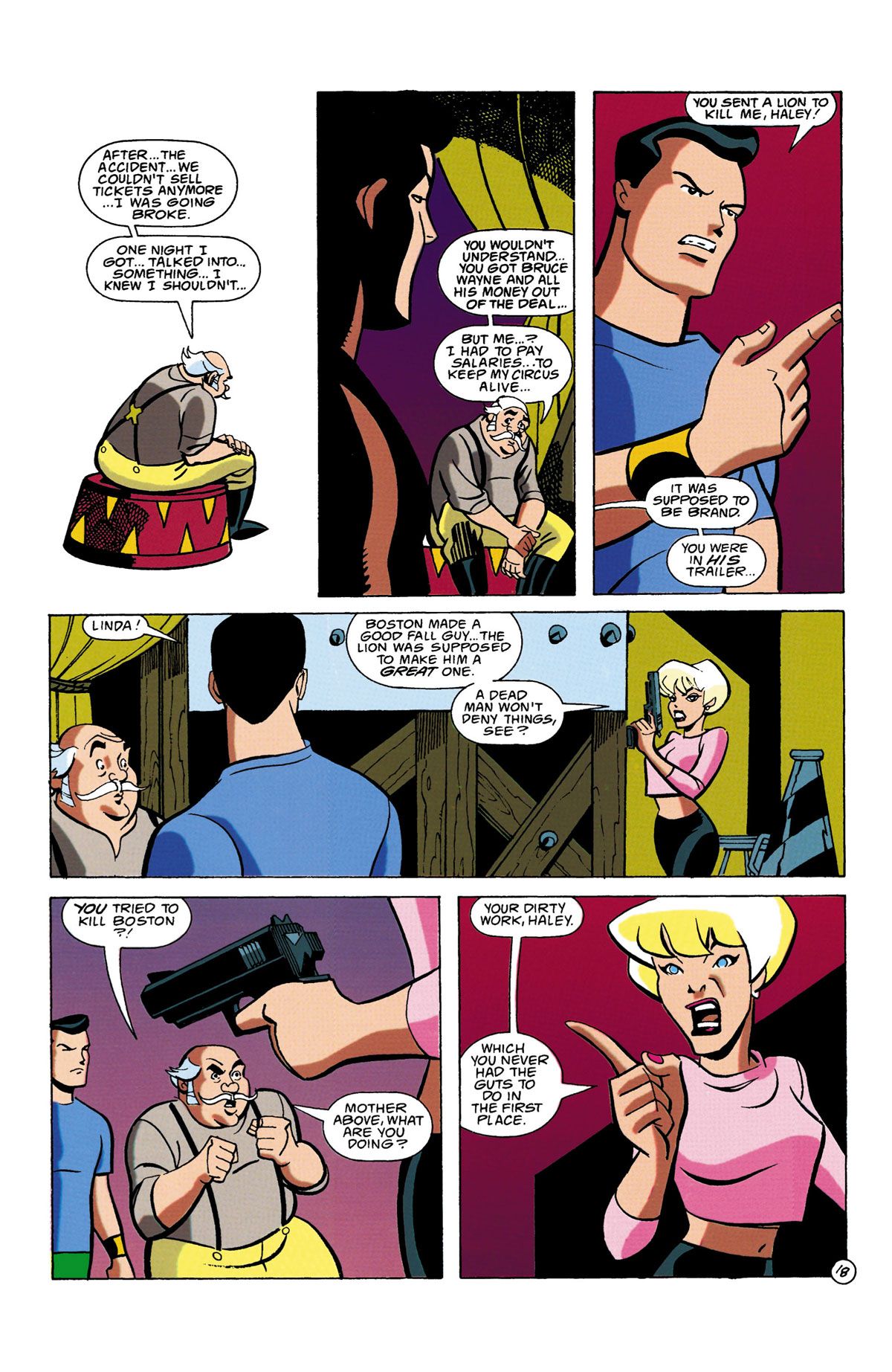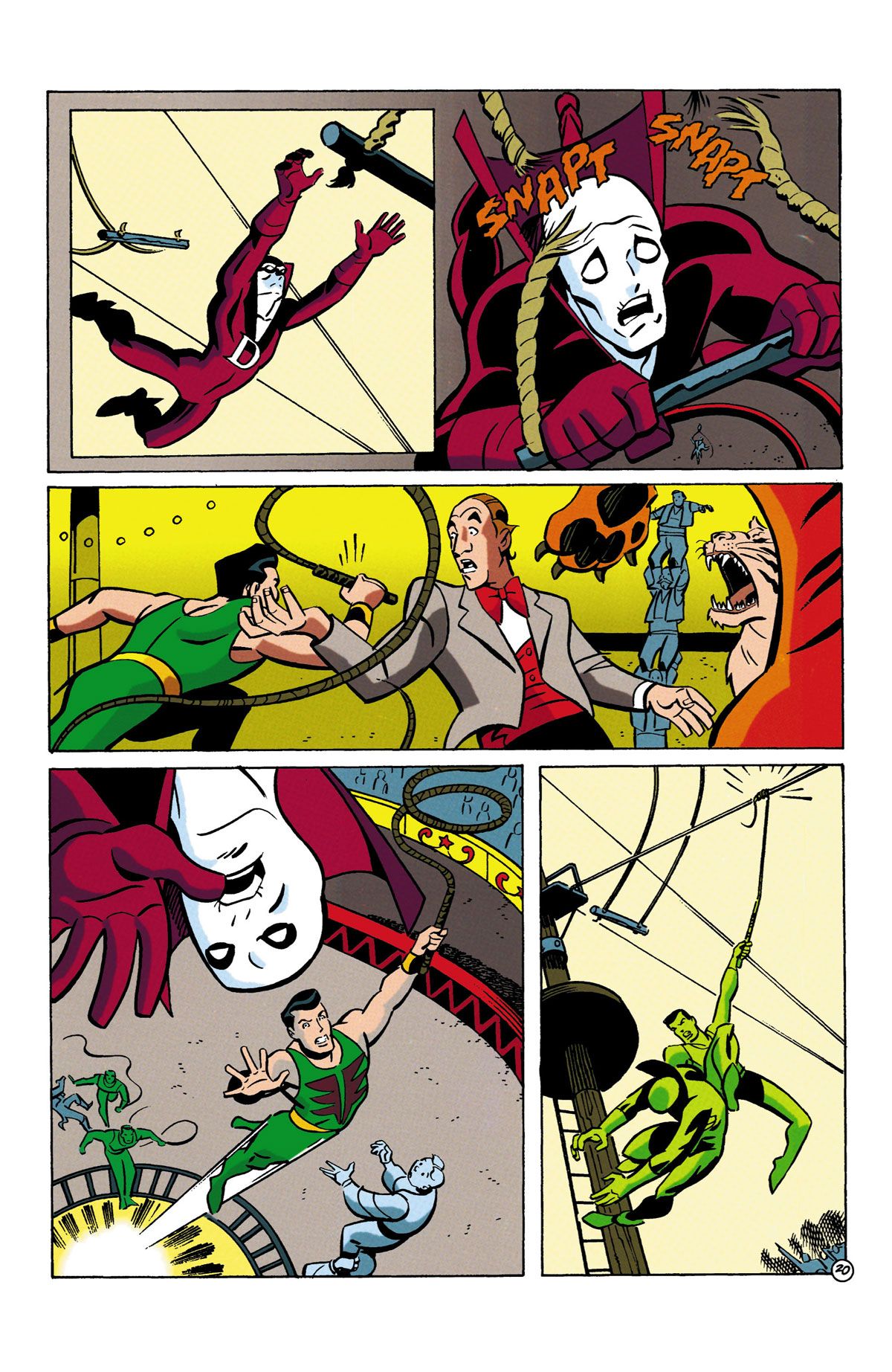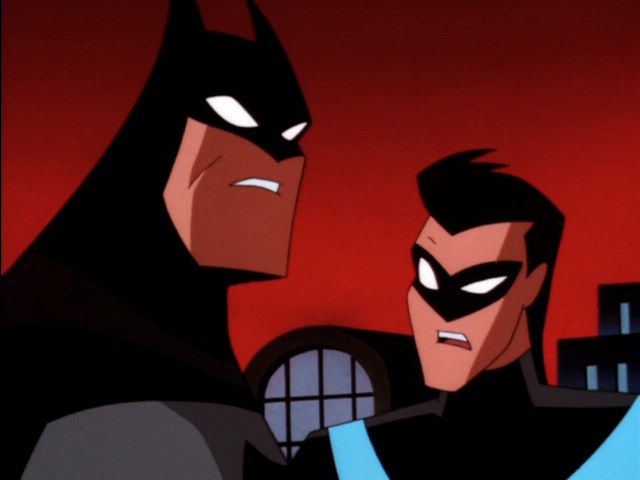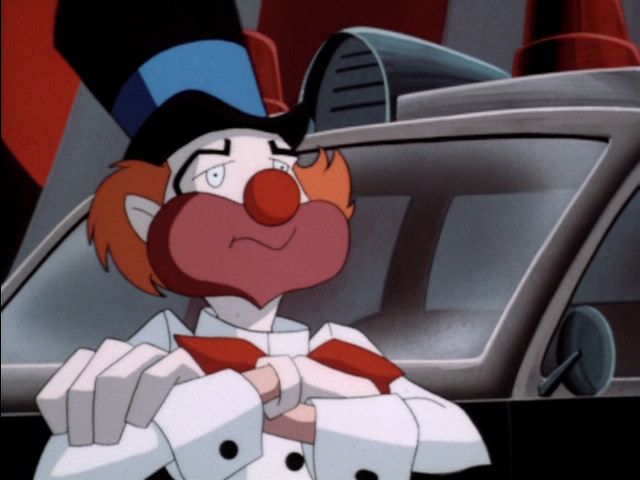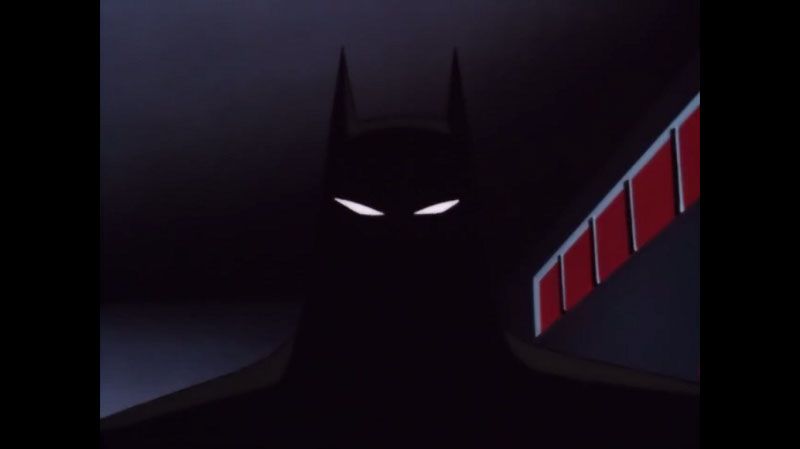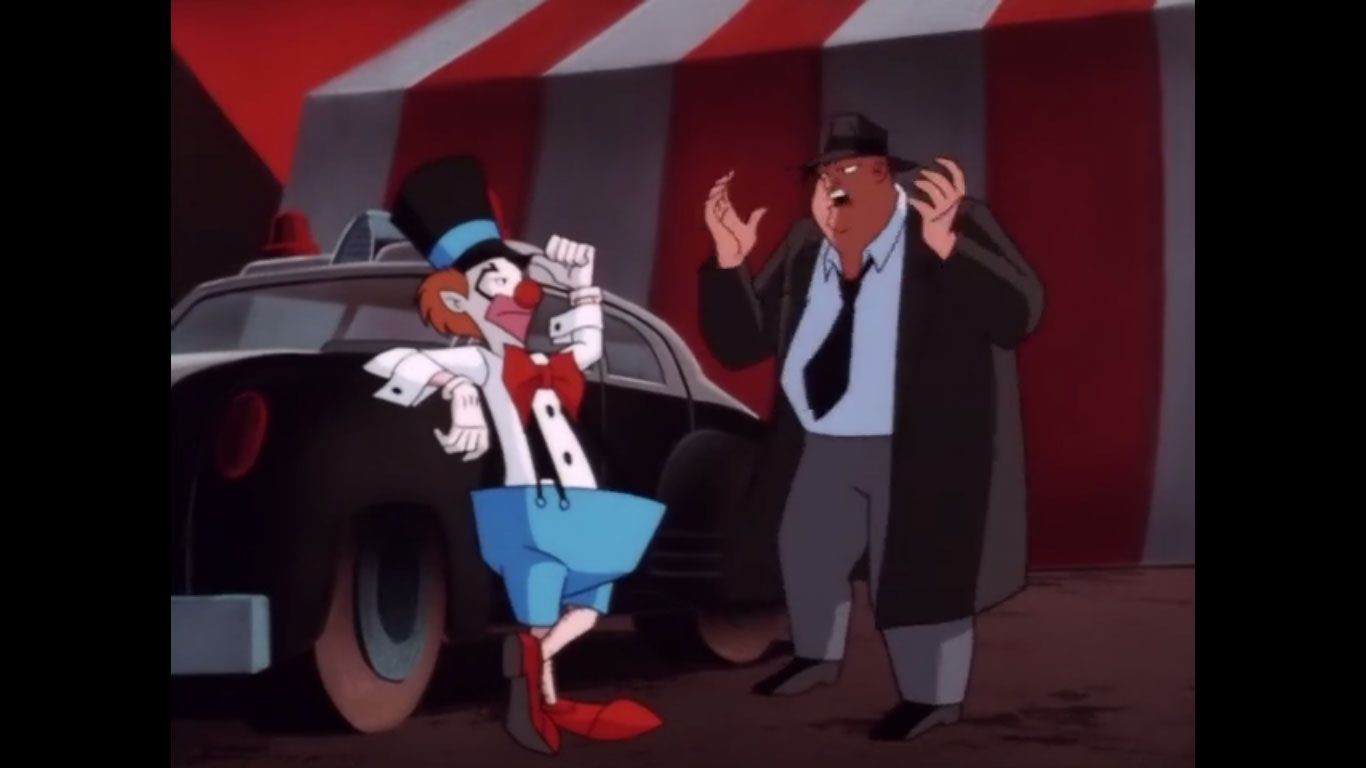Welcome to the nineteenth installment of Adventure(s) Time, a look back at a classic animated series and a related issue of its comic tie-in. Suggestions are always welcome, so if you have pairings you’d like to see, let me know in the comments. This week, we’re examining the Haley Circus…and how it became implicated in two separate robbery sprees.
RELATED: Which Batman: The Animated Series Episode is an Overlooked Classic?
The Haley Circus (spelled with an "e" in this canon) has been a part of Dick Grayson’s backstory since the beginning, and the tale of the Flying Graysons’ death in the big top was rather faithfully recreated on Batman: The Animated Series in the “Robin’s Reckoning†episodes. During the initial run of the series, however, that was it for Haley’s Circus. Writer Ty Templeton, meanwhile, a devoted Bat-fan and longtime writer of the tie-in comic, had a habit of pulling in elements from the past and using them as the starting point for current-day stories. In Batman & Robin Adventures #15 (February 1997), Ty Templeton and artist Brandon Kruse present a story that has the Haley Circus return to Gotham, years after Dick Grayson left to become Robin.
Oh, yeah…and Deadman was there, too.
Within the opening pages of the issue, we discover the Haley Circus has set up its tents in Gotham, apparently unannounced, just a few blocks away from the home of Wayne Industries executive, Lucius Fox. Bruce Wayne and Dick Grayson stop by, allowing Dick his first chance in years to see his “boyhood home.†Dick discovers that the role of trapeze artist has been taken by Boston Brand, an irritable grouch who goes by “Deadman†while performing. Boston makes it clear that he has no time for Dick; his animus explained by years of resentment (after consistently being compared to the Flying Graysons), and just a general hatred of rich people.
Not long after arriving at the circus, Alfred informs Bruce and Dick of a police report originating from Lucius Fox’s home. As Batman and Robin, they apprehend four burglars. Two of them are locals; the other two are Haley Circus employees. Dick researches previous stops of the circus, and sees a pattern of burglaries in homes close to the big top. Dick declares this is a case he must work alone, and Bruce isn’t seen again until the final page of the story. This is the most Robin-centric issue of the run, giving fans who never got that rumored Robin animated series in the ‘90s a chance to see Dick Grayson work solo.
With Mr. Haley’s permission, Dick returns to the circus as a trapeze artist. The most obvious suspect in the robberies is Boston Brand, even though the other circus employees, including Boston’s girlfriend Linda, insist he’s a decent guy. Boston does little to endear himself to Dick, however, going out of his way to embarrass Dick whenever he can.
While snooping around Boston’s room, Dick is attacked by a freed lion, providing Dick even more evidence that Boston is up to something. After voicing his suspicions to Mr. Haley, Dick discovers Boston is leaving the circus after tonight’s show. As the Deadman prepares for his performance, Dick returns to his room, and during the second investigation of Boston’s chest, discovers a collection of priceless jewelry. Dick can now crack the case -- but he doesn’t like the answers.
RELATED: Batman: The Animated Series Pop! Vinyls Go Rogue with New Funko Toys
Since there was nothing in the chest minutes earlier, the culprit has to be the one person who knew Dick was returning to Boston’s room -- Mr. Haley. This begs the question of why Dick was looking through the same chest twice, when he knew Boston didn’t have a chance to return to his room (so what was he expecting to find?), but, uh…look over here! It seems that Haley isn’t the only rat in this circus; Boston’s gal pal Linda has been in on the scheme since the beginning.
While Mr. Haley is given a sympathetic motive for his crimes, Linda is pure evil. Not only is she willing to kill anyone who interferes with her plan, but she’s also arranged for her boyfriend to die tonight, right after he’s framed for her crimes. Mr. Haley is given a redemption moment when he punches the pistol out of Linda’s hands, allowing Dick a chance to rescue Deadman before the rope Linda cut earlier kills him.
After telling Deadman the truth about Linda, and calling the cops on Mr. Haley, Dick is left alone, contemplating the advice Deadman gave him earlier -- “You can’t trust anyone and life stinks.†He feels that way until Bruce emerges from the shadows, offering his ward a sympathetic ear and the assurance that he knew Dick could take care of things.
The plot isn’t airtight, but it’s all very touching, and the way Templeton structures the climax so that Dick is now able to save someone from falling from the ropes (after years of blaming himself for not rescuing his parents) is a great character moment. Dick Grayson narrates the issue, bringing a sense of sentimentality and nostalgia to the story…in-between the investigation and circus animal fights, of course.
Months after the publication of this comic, Batman: The Animated Series was revamped as The New Batman Adventures, moving the continuity closer to the comics, with a more intense Batman, a new kid Robin named Tim Drake, and Dick Grayson as the independent hero Nightwing. And if the thought of having Dick investigating the Haley Circus while reflecting on his past was good enough for the tie-in comic, the animated series could also make it work, right?
The result is a notably unpopular episode, one dismissed by producer Bruce Timm as one of the weakest DC Animated Universe episodes ever created. "Animal Act" originally aired on September 26th, 1998, from writer Hilary J. Bader (who wrote a large percentage of the DCAU episodes in the late ‘90s), and director Curt Geda. The animation is provided by Koko and Dong Yang Animation, two of the best studios to work on this batch of episodes. The story opens with Batman and Robin on a rooftop patrol, their evening interrupted by Nightwing’s sudden appearance.
Batman’s dismissive of Nightwing as soon as he arrives, chastising him for his allegedly noisy entrance. Batman’s attitude towards his former ward doesn’t change much during the episode, even though this follows their reconciliation in the “Old Wounds†episode. This is the harsher Batman from the late Denny O’Neil era of the comics, an interpretation that made its way into the concurrent New Adventures episodes. While the producers were more willing to portray Batman as cold and antisocial in these episodes, the plots during this run tend to be much lighter than the standard Animated Series fare. Case in point, this episode, which features animals from Haley’s Circus breaking free and committing robberies across Gotham.
RELATED: In Nightwing: The New Order, Dick Grayson Kills the DC Universe
The premise is downright silly, but what the episode has in its favor is consistently fluid animation. Batman himself looks particularly nice in this episode, even though he’s not exactly the center of the story. Much like the preceding Adventures comic, Dick Grayson is the hero with a personal stake in this crime spree. And while Ty Templeton’s story had Batman stepping off the case and allowing Dick Grayson the freedom he needed to investigate the crimes, in Hilary J. Bader’s plot, Batman’s consistently looming over Dick’s shoulder, second guessing him and implying that Dick’s too close to the case to see what’s happening.
Batman’s working theory is that Dick’s childhood friend Miranda, now the circus’ animal trainer, is freeing the animals at night and sending them off on a crime spree. The story does treat Miranda as the likely culprit…which is a pretty clear sign that she’s only here as a red herring. Some emotion is added to the story, when Dick reflects on his past with the circus, and there’s some hint of romance between Dick and Miranda (voiced by Jane Wiedlin of the Go-Gos, by the way), but most of these scenes come across as filler until the next circus animal attack.
And the true culprit behind these crimes? The Wheel of Arbitrary Batman Villains has been spun, and it turns out the secret scoundrel is none other than the Mad Hatter. This week, he’s disguised himself as a clown while furtively overseeing his fiendish, and frankly dumb, scheme.
And while actor Roddy McDowall is as excellent as ever in this role, he’s given the weakest Mad Hatter material yet, making this a sad farewell for McDowall’s interpretation. The best Mad Hatter stories have him attempting to find some happiness for himself, or as a defense mechanism, distracting Batman with manufactured images of a life Batman knows he can’t have. What’s Hatter’s scheme here? To brainwash animals into stealing electronic equipment that he’ll use in his future schemes. That’s pretty lame all around. And the ending of the episode, a play on the old joke about the circus employee who’s content cleaning elephant dung because it’s “still show business†-- who thought this was a good idea? Wouldn’t a final farewell between Dick and Miranda, or an apology from Batman to Nightwing, or pretty much anything, be better than this?
The Wrap-Up
Design-y
The opening of "Animal Act" is a lovely example of the red sky effect seen in the New Adventures episodes. The new color schemes for Batman and Robin also look great here. Plus, there’s a classic “all shadow†appearance by Batman during one of his conversations with Nightwing.
And even though the series didn’t embrace retro designs during the New Adventures era, the design of Harvey Bullock’s police car looks like something from the original run of episodes.
Continuity Notes
- In "Animal Act," the Mad Hatter claims his mind control devices only work on humans in close proximity, but when used on animals, the mind control chips can work over great distances. However, the very first time we saw the Hatter use his mind control technology on humans, back in his first appearance in “Mad as a Hatterâ€, the two thugs who were ordered by him to go jump off a bridge traveled several miles while still under his control.
- In previous appearances, the mind control devices used by the Mad Hatter on humans have been rather small. Growing smaller with each appearance, actually. In this episode, the devices he plants on the circus animals (who have smaller brains than humans) are massive in comparison.
- When "Animal Act" aired, Ty Templeton stated online he was pleased nothing in the episode contradicted the story in Batman & Robin Adventures #15.
- When Deadman later appeared on the Justice League Unlimited series, Batman was already familiar with him. Since there was no great reason in that episode to establish a history between Batman and Deadman, many fans interpreted it as a nod towards this issue of Batman & Robin Adventures, and a later Deadman appearance in Batman: Gotham Adventures #6.
“Huh?†Moment
If the Haley Circus has been in financial trouble since Dick Grayson left as a young man…that’s been at least ten years! Has Mr. Haley really been running this scam for over a decade without being caught? And if the robberies are going to continue, how does framing and killing Deadman solve anything? Won’t Linda have to find, and kill, a new patsy for each town the circus visits?
Battle of the Big Top Returns
These two stories have a similar starting point, and even hit many of the same beats, but "Animal Act" appears to be a case of a solid premise that’s simply squandered. Some fans fight vociferously against the idea that the New Adventures episodes were more kid-friendly, but how else can you describe an episode that has Batman and friends facing off against a menagerie of brainwashed circus animals? Not every episode has to be deep, and there are sillier episodes that older fans do enjoy, but using what could’ve been an excellent character piece for Dick Grayson and wasting it on goofy hijinks is hard to forgive. And when the mature, caring Batman of Ty Templeton’s story is contrasted against the unfeeling jerk in the animated adventure, there’s no contest. The superior tale of Dick Grayson’s return to his roots can be found in Batman & Robin Adventures.
That’s all for this week. If you’d like to suggest a future cartoon/comics pairing, just leave a comment or contact me on Twitter.

